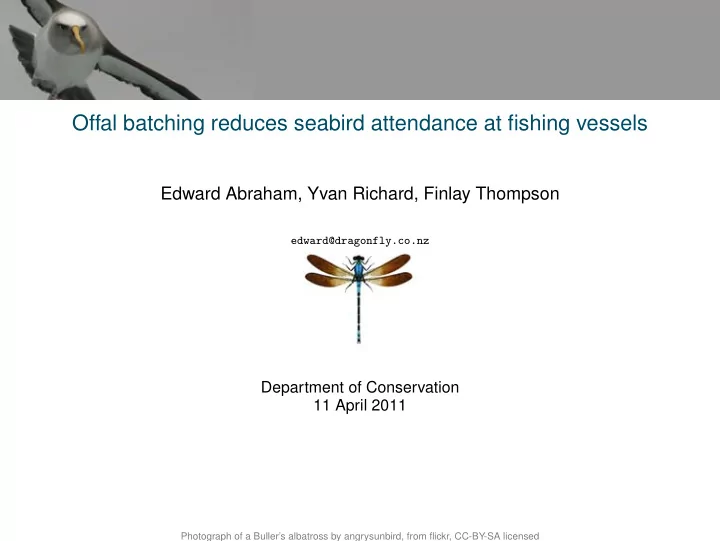

Offal batching reduces seabird attendance at fishing vessels Edward Abraham, Yvan Richard, Finlay Thompson edward@dragonfly.co.nz Department of Conservation 11 April 2011 Photograph of a Buller’s albatross by angrysunbird, from flickr, CC-BY-SA licensed
Introduction Offal is the key • Seabirds are attracted to trawlers by discards, processing waste, and by the catch • While feeding, they may be struck by trawl warps and killed • Warp strike observations show that few strikes occur if there is no waste discharge
Introduction Mealing, mincing, batching • Previous studies have shown that when a meal plant is used, and so all processing waste is retained, then there are fewer birds attracted to the stern of vessels • One approach to reducing interactions include mincing offal so that it disperses further than the stern • Another approach is to batch the offal and discard it at intervals • A previous study found that as the batch interval increased from thirty minutes to four and eight hours, there was some decrease in the numbers of birds that were attracted to the discharge events
Introduction The 2010 experiment • In 2010, the batching experiment was repeated on a trawler fishing for hoki and beryx species • The number of birds behind the vessel were compared between continuous discharge, and discharge at 30 min and 2 hour intervals • In this report, a preliminary analysis of the results is presented
Introduction The Mitigation TAG • The experiments coordinated by the Mitigation Technical Advisory Group • Collaboration between DOC, MFish, NGO’s, SeaFIC, fishing industry, and research providers • 2010 batching experiment carried out by a fisheries observer with support from vessel crew • Vessel operations coordinated by John Cleal (Vessel Management Services Ltd) • Project and preliminary analysis funded by DOC CSP • Further analysis funded by ACAP
Protocol Discharge and seabird abundance • The number of birds behind the vessel are counted • Counts made during both fishing and processing • Normal fishing carried out • Discharge either continuous, 30-min batches, or 2-hour batches
Protocol An observation • Counts made of • Large birds (Albatrosses and giant petrels) • Cape petrel ( Daption spp.) • Small birds (other birds) • Counts made with 10 m and 40 m sweeps • Counts made of birds in air and on water • Up to 12 counts in a session
Seabird species Type Species Code Abundance mean min–max Large Unidentified small albatross XMA 38.6 10–100 Salvin’s albatross XSA 38.4 5–80 Giant petrel XTP 25.8 10–90 White-capped albatross XWM 24.1 0–80 Buller’s albatross XBM 18.4 0–60 Unidentified large albatross XAL 14.2 5–40 Small Westland petrel XWP 39.3 10–80 Unidentified petrel XPE 27.9 0–80 Grey petrel XGP 12.3 0–40 Cape petrel Cape petrel XCP 4.1 0–30
Total counts continuous 30min 800 2h discharge Seabird abundance 600 400 200 0 Feb 10 Feb 15 Feb 20 Feb 25 Mar 02 Mar 07 Mar 12 Date
Effect of discharge continuous 30min 2hr 800 • Difference between treatments due to the greater time spent Seabird abundance 600 discharging in the continuous treatment 400 • Proportion of observations with discharge: 97% continous, 22% 200 (30-min), and 25% (2-hour) • Typical duration of a session was 40 min (a maximum of 55 min) 0 When When not Overall discharging discharging
Effect of discharge 300 continuous 60 continuous 30min 30min 2hr 2hr 250 50 200 40 Abundance within 40 m Abundance within 10 m 150 30 100 20 50 10 0 0 Large seabirds Small seabirds Large seabirds Small seabirds
Time response (total birds, 40 m) Discharge continuous Abundance of all birds within 40 m 30min 800 2h mean 600 400 200 0 -10 0 10 20 30 40 50 Time from discharge (minutes)
Time response (total birds, 10 m) Discharge continuous Abundance of all birds within 10 m 30min 80 2h mean 60 40 20 0 -10 0 10 20 30 40 50 Time from discharge (minutes)
Discharge duration 25 • Average duration of discharge was 3.1 min for 20 Duration of discharge (min) the 30-min treatment, and 9.4-min for the 2 hour treatment 15 • Relative effect of 2-hour and 30-min treatment 10 would depend on the speed of the response of birds to the discharge event 5 • Unable to determine this from the 5-min count protocol 30min 2hr Discharge interval
Summary • Continuous discharge maintains a high number of birds close to the vessel • Bird numbers increase and decrease rapidly in response to discharge events • This results in fewer birds behind the vessel during batched treatment • Will quantify the difference using statistical analysis of the data
Recommend
More recommend